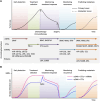Liquid biopsy for diagnostic and prognostic evaluation of melanoma
- PMID: 39156972
- PMCID: PMC11327088
- DOI: 10.3389/fcell.2024.1420360
Liquid biopsy for diagnostic and prognostic evaluation of melanoma
Abstract
Melanoma is the most aggressive form of skin cancer, and the majority of cases are associated with chronic or intermittent sun exposure. The incidence of melanoma has grown exponentially over the last 50 years, especially in populations of fairer skin, at lower altitudes and in geriatric populations. The gold standard for diagnosis of melanoma is performing an excisional biopsy with full resection or an incisional tissue biopsy. However, due to their invasiveness, conventional biopsy techniques are not suitable for continuous disease monitoring. Utilization of liquid biopsy techniques represent substantial promise in early detection of melanoma. Through this procedure, tumor-specific components shed into circulation can be analyzed for not only diagnosis but also treatment selection and risk assessment. Additionally, liquid biopsy is significantly less invasive than tissue biopsy and offers a novel way to monitor the treatment response and disease relapse, predicting metastasis.
Keywords: circulating biomarkers; diagnosis; liquid biopsy; melanoma; prognosis.
Copyright © 2024 Slusher, Jones and Nonaka.
Conflict of interest statement
The authors declare that the research was conducted in the absence of any commercial or financial relationships that could be construed as a potential conflict of interest.
Figures


References
-
- Alix-Panabières C., Pantel K. (2021). Liquid biopsy: from discovery to clinical application. Cancer Discov. 11 (4), 858–873. 10.1158/2159-8290.CD-20-1311 - DOI - PubMed
Publication types
Grants and funding
LinkOut - more resources
Full Text Sources

